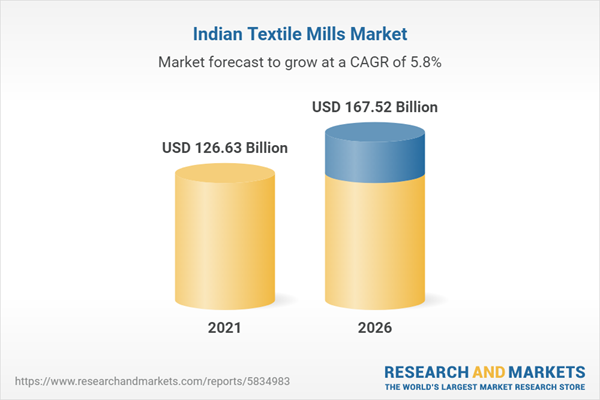Textile Mills in India industry profile provides top-line qualitative and quantitative summary information including: market size (value 2016-21, and forecast to 2026). The profile also contains descriptions of the leading players including key financial metrics and analysis of competitive pressures within the market.
Key Highlights
- The textile mills market includes yarns and fabrics. The value of each segment is for consumption, defined as domestic production plus imports minus exports, all valued at manufacturer prices.
- The Indian textile mills market had total revenues of $126.6 billion in 2021, representing a compound annual growth rate (CAGR) of 0% between 2016 and 2021.
- The fabric segment was the market's most lucrative in 2021, with total revenues of $117.6 billion, equivalent to 92.8% of the market's overall value.
- The Indian textile mills market is one of the largest in the world, with large raw material base and manufacturing strength across the value chain, and that plays an important role in developing the social and economic performance of countries around the globe.
Scope
- Save time carrying out entry-level research by identifying the size, growth, major segments, and leading players in the textile mills market in India
- Use the Five Forces analysis to determine the competitive intensity and therefore attractiveness of the textile mills market in India
- Leading company profiles reveal details of key textile mills market players’ global operations and financial performance
- Add weight to presentations and pitches by understanding the future growth prospects of the India textile mills market with five year forecasts
Reasons to Buy
- What was the size of the India textile mills market by value in 2021?
- What will be the size of the India textile mills market in 2026?
- What factors are affecting the strength of competition in the India textile mills market?
- How has the market performed over the last five years?
- What are the main segments that make up India's textile mills market?
Table of Contents
1 Executive Summary
2 Market Overview
3 Market Data
4 Market Segmentation
5 Market Outlook
6 Five Forces Analysis
7 Competitive Landscape
8 Company Profiles
9 Macroeconomic Indicators
10 Appendix
List of Tables
List of Figures
Companies Mentioned (Partial List)
A selection of companies mentioned in this report includes, but is not limited to:
- Grasim Industries Limited
- Arvind Ltd
- Raymond Ltd
- The Bombay Dyeing and Manufacturing Co Ltd
- Vardhman Textiles Ltd
Table Information
| Report Attribute | Details |
|---|---|
| No. of Pages | 50 |
| Published | August 2022 |
| Forecast Period | 2021 - 2026 |
| Estimated Market Value ( USD | $ 126.63 Billion |
| Forecasted Market Value ( USD | $ 167.52 Billion |
| Compound Annual Growth Rate | 5.7% |
| Regions Covered | India |









